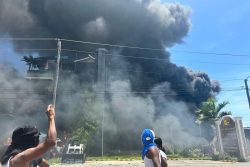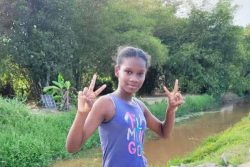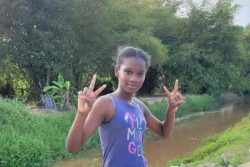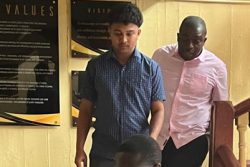What is Guyanese Art? To what extent can this be answered by the exhibition ‘Abs-tract Art in the National Collection currently on show at the National Gallery, Castellani House? Just how difficult is it to decide what constitutes a national art? The work is never going to be homogenous, and quite rightly so; therefore can this be satisfactorily identified in Guyana when the artists are so different?
Last week we analysed issues regarding national literature, and touched on what criteria may be used and what rejected in arriving at what is Guyanese Literature. Just like the artists, all writers do not do the same thing either. Hallelujah! But we talk about Guyanese literature without hesitation, and might even be able to define it. The national Independence Anniversary always offers an opportunity for highlighting or celebrating Guyanese Literature, and that will be even more glorified when the 50th Anniversary arrives.
In the same way, it will be apposite to give equal consideration to Guyanese Art, if it is possible to decide whether it exists and what it may be. Indeed, the ongoing exhibition ‘Abstract Art in the National Collection has been mounted and promoted as “celebrating the 49th Anniversary of Independence of the Republic of Guyana.” It also celebrates International Museums Day 2015 – ‘Museums for a Sustainable Society.’ It continues the tradition at Castellani House where for many years the Curator has shown selections from the National Collection according to a theme each year, featuring both Pre-Independence and Post-Independence Guyanese Art.
 But now the glib use of that term has been called into question. Some leading artists say that you cannot talk about Guyanese Art; it is more accurate to say art in Guyana, because what exactly are you going to identify as Guyanese art? Which pieces and which artists, which body of work can you single out as representing this? They argue that there are strong claimants – there is the Lokono art, but there are the Moschettes and the Greaveses, which are you going to choose? All the artists do different things, produce different ‘schools’ and ‘movements’ in addition to their individual preoccupations, and this makes it very difficult to identify what is the national art.
But now the glib use of that term has been called into question. Some leading artists say that you cannot talk about Guyanese Art; it is more accurate to say art in Guyana, because what exactly are you going to identify as Guyanese art? Which pieces and which artists, which body of work can you single out as representing this? They argue that there are strong claimants – there is the Lokono art, but there are the Moschettes and the Greaveses, which are you going to choose? All the artists do different things, produce different ‘schools’ and ‘movements’ in addition to their individual preoccupations, and this makes it very difficult to identify what is the national art.
Haiti – a country where national arts are soon to be exhibited in Carifesta XII – has been called up as a witness. It is argued that Haitian Art stands out and is famously easily identified; it has a quality and identity that marks it right away as Haitian. It is true that Haitian art has a quality that goes deep, and that enriches it and gives it great appeal – that is the prominent use of the traditional and the strong African spirituality that have survived in that country. But one has to be careful about thinking that every Haitian sculptor or painter produces the same work. They do not. One needs also to remember the strong pull of the tourism market and the demand for a particular brand of art. One needs, in addition, to be aware of typifying individual artists and stereotyping a national work.
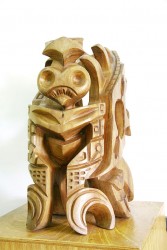
Alim Hosein and Ohene Koama introduce the ‘Abstract Art’ collection with reference to the way the nation’s anniversary relates to demonstrations of its art. “The theme of independence in the air turns our attention to independent-thinking artists whose works add a special dimension to the national collection.” (From the article ‘Independent Pathway’, Exhibition Catalogue, May 28, 2015) They acknowledge the early Guianese artists “mostly landscape painters who pursued the Romantic and Impressionist styles of the late 19th Century to early 20th century.” They refer to the way Guyana’s art “has retained a figurative character throughout its history” and “how interested our artists are in concretely depicting the life around them. We see this in painting, for example, where it reaches a high point in the photo-realistic images of Carl Anderson.” It is also there in Winslow Craig’s “life-like depiction of animal and human bodies . . . Bernadette Persaud’s lush paintings of the Botanical Gardens and the paintings of countless scenes of Guyana by other artists [which] depict the country’s flora.”
Truly, landscape painting and realistic – even photo-realistic works are major features of Guyanese Pre-Independence art, and it has also persisted in the decades after. Craig and Persaud are prominent among contemporary Post-Independence artists and they have their own thematic and stylistic pursuits. While one can identify important general characteristics about the work of the artists as a whole, there are several areas of differences among independent-thinking artists, who, nevertheless add “special dimensions to the National Collection” and to Guyanese art.
Yet, Hosein and Koama observe that even figuration itself is treated in different styles, that there have been major movements towards abstract art among the artists and that “this approach is by no means a recent development in Guyana. Our artists have been producing work in an abstract vein since the late 1950s.” They then identify a factor that has been a major shaper of art in Guyana if one is trying to see national characteristics. That is “the search for a sense of self.” The way they put it, “As a former colonial people, many Guyanese look for a self-definition that is more real to us.”
The development of Guyanese literature is not far away from that. The 1930s saw major cultural movements in search of self-definition among people conscious of their Indianness and Africanness which carried over into the way the literature developed. In the art such ethnic consciousness has played a part, not necessarily in the same era. After the Working People’s Art Class, it developed among some of its students notably Philip Moore and people he influenced such as Omowale Lumumba and Gary Thomas who developed interest in ‘roots’ and African ancestry. The subtle strains may be identified in Stanley Greaves’s deep interest in intuition and folk. There was the major rising of Lokono artists in the late 1980s and the much more recent Indian preoccupations seen in Bernadette Persaud and Philbert Gajadhar. These are significant veins in the national art.
In this year’s Independence exhibition there is an abundance of diversity and independent thinking. Yet in several instances independent preoccupations are parts of larger movements in the art of the nation. Let us take landscape, for instance, which is major, as was previously mentioned. The artists approach landscape in many different ways, even in the abstract art of Cletus Henriques, for example. His Roraima (1968) represents the way the landscape, the awesome interior and definitions of the “Dear Land of Guyana” (the title of a previous Independence exhibition) which surrounds the artist is represented in forms of abstraction. This is also the case in Dudley Charles’ River Spirit (1985).
While selections from George Simon are few in this show, they loom large, not only in the exhibition hall, but in the national art. Tree Root (2013) may be placed alongside the Charles and the Henriques mentioned above, except it is part of a more recent and more impactful development. The rise of Lokono art was an extremely important development in Guyanese art, starting in the very late 1980s but announcing its arrival with heavy seismic proportions in the 1990s with the emergence of the group Simon taught in St Cuthbert’s Mission. Simon’s work has been a step ahead of those in his bold adventures into the avant-garde, into post-modernistic excursions in a merger of traditions and styles. Homage to Wilson Harris: Secret Ladder #3 (2012) delves into the interior landscape in the abstract fashion comparable to Harris in literature. It is an example of the outer frontiers reached in Amerindian art – the Amerindian consciousness in Guyanese art.
Although Oswald Hussein was preceded by Simon, who is his brother, in ascendancy in national art, it was his meteoric explosion in the late 1980s that heralded the Lokono rising. The other sculptors who followed his innovations in ethnic spiritualism came to public notice in that very famous ground-breaking exhibition at the Venezuelan Cultural Centre (Six Lokono Artists). Hussein’s work in this exhibition, Wegeliy, (1993) in particular, and Bush Hunter (2013) demonstrate his abstract representations of forest spirits and animals out of the Amerindian consciousness. His place in Guyanese sculpture equals his brother’s in Guyanese painting. They are individuals, but contribute to an important component of the national art.
Included in the art of the Guyanese nation is that work led by Simon and Hussein which speaks to national heritage; but this heritage in the national art is not only work by Amerindians. Donald Locke’s Indian Shooting Fish (1967) while not going as deep as the Lokono, reflects the environment that is now important in the art. His Abstract Rice Fields (1967) does in abstract art what Hosein says the realists do in “depicting the life around them.” Of course the Aubrey Williams extensive suite of paintings rooted in the Amerindian motifs and the Timehri petroglyphs is well known, and these are a part of the abstract work based on heritage. (See Arawak IV, 1972 and Timehri Rock Drawing, nd, in this exhibition).
Greaves’ Cock of the Rock (1971) joins those works and is evidence of that artist’s diversification in his paintings and sculpture. Ron Savory’s Bowman (1967) fits in the category of the heritage, as does Parboo Singh’s Untitled (nd), but Savory’s piece also belongs to his extensive explorations of interior landscape and the world of the porkknockers.
A perusal of this exhibition is evidence that there is a Guyanese Art. One continues to be grateful for the lack of homogeneity, but rejoices at the powerful statements made about the art of a nation. Clearly the painters and sculptors pursue independent ideas but there are definite demonstrations that this art in Guyana has within it several pieces that exhibit what constitutes Guyanese Art. To a large extent, Guyanese art is what the artists are and have been doing. It may be defined by the different major ‘movements’ and ‘schools’ that have happened to evolve within it.
About the art, Hosein concludes, “the intellectual contribution this has made to Guyana’s independence is considerable and not yet fully realised or explored.” He refers to the way writers such as Harris and Martin Carter defined Guyanese literature. The “local creators . . . wished to express themselves as Guyanese. Like Carter, they ‘would shout it out differently/if it could be sounded plain.’ Abstractionism in Guyanese art, therefore, while it may be related to the modernist movements in Europe that started in the mid-nineteenth century, also has definite roots in the Guyanese psyche.”



